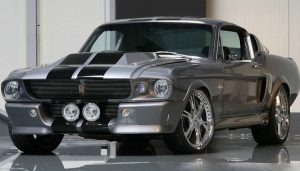McLaren P1
The McLaren P1 is the successor to the famed F1 and has quite a reputation to uphold. It does so quite well, with a 3.8-liter V-8 engine with twin turbochargers, producing 727 horsepower. The P1 is also a hybrid hypercar, adding a 177-horsepower electric motor for a total of 904 ponies.
Where does all that power rank the McLaren P1? Well ahead of any current Corvette. 0-60 times are close — 2.8 seconds for the McLaren P1 and 2.95 seconds for the current C7 Z06 Corvette. But could the ‘Vette vie for 0-186 miles per hour in anywhere near 16.5 seconds? Maybe not, but the Z06 has done 0-150mph in 17.7 seconds, which is not too shabby.
The McLaren pedigree is quite similar to the Corvette. McLaren builds cars that compete and win in the Formula One Championship, and the McLaren P1 comes in both a street-legal and a track-ready version. Chevrolet builds affordable Corvettes to appeal to the average American, yet the brand still boasts a highly successful 60-year racing history that includes eight wins at the 24 Hours of LeMans.
Audi R8
The Audi supercar, based on the Lamborghini Gallardo platform, has a target on its back if the Corvette truly gets a mid-engine design. Though it truly is a performance car, the Audi R8 doesn’t put up the numbers that cement its place in the supercar category. It has much in common with the Lamborghini Gallardo, which is a step below the Huracan.
The Audi does have sufficient power to be classified as a supercar, with either 540 hp in the V10 or 610 in the V10 Plus. That being said, the R8 only musters around 3.5 seconds sprinting to 60 mph. The Audi R8’s claim to fame is its no-fuss Quattro permanent all-wheel drive. Quattro sticks the R8 to the road in the corners, which helps explain why Audi R8’s have the 38th and 52nd best overall times at Germany’s famed Nurburgring track.
The C7 Corvette Z06 beats the R8 in overall road handling without AWD, though, nabbing 15th place in the Nurburgring times. While R8 buyers may be diehard Audi fans, the Corvette will outperform the R8 every time.
Ford GT
The 2017 Ford GT is set to be released late in 2016 with a limited production of 250 vehicles per year. This car is likely why Chevy wants to enter the mid-engine market themselves — to take down their Blue Oval competition. The Ford GT is expected to make around 630 horsepower from its twin-turbocharged V-6 derived from Ford’s Daytona Prototype race engine.
No one yet knows how quickly the 2017 Ford GT is expected to accelerate from 0-60 miles per hour. While its power rating is close to that of the current Corvette Z06, the Ford’s curb weight of about 2,890 pounds undercuts the C7 Corvette’s 3500+ pound weight by over 600 pounds. In terms of power to weight, the Ford GT has the C7 beat, but who knows what the C8 Corvette will weigh in at? It is likely to use the same types of composite materials that the Ford has used to keep its weight as low as possible.
Ford has a great racing heritage, just as Corvette does. This new Ford GT won its class in this year’s 24 Hours of Le Mans (actually taking first, third, and fourth), exactly 50 years after taking on and beating Ferrari at LeMans with the original Ford GT-40.








